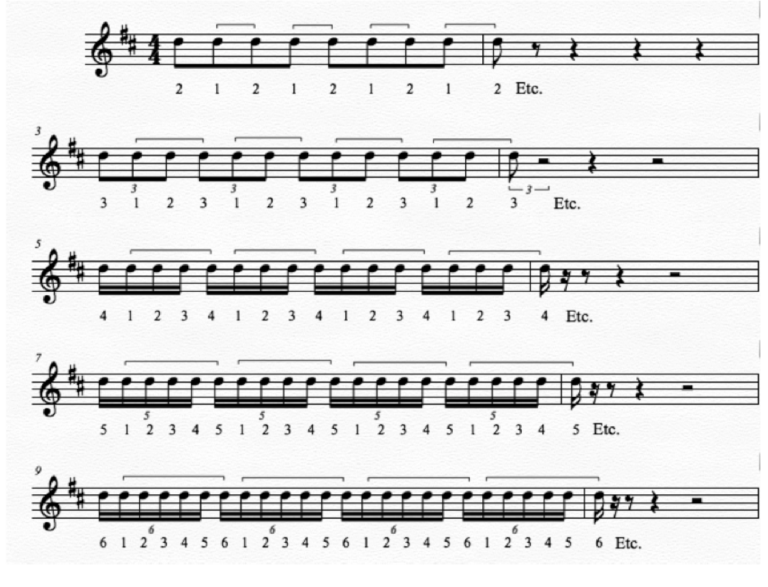by Laila Storch, 1968
During the time I studied with Marcel Tabuteau from 1943 to 1946 at the Curtis Institute of Music, and for several years afterwards for briefer periods whenever possible, I often made a few notes after lessons.
The woodwind ensemble, the string classes and the small orchestra, all of which he conducted, were like extra lessons. In the woodwind class while under the pressure of trying to play one or two measures, (or even notes!!) to meet with his approval, it was naturally impossible to write anything. But sometimes listening to the string class, I would jot down some of his explanations and reflections. And so I find the following words, marked ‘March 1943′:
“After 30 years there is not a day that I don’t think fifty times of what my teacher told me. Only now I really profit from what he advised – to get a little rubber ball. Music to be phrased must respond to the fundamental laws of nature – it must be scaled and rebound, like the ball, less and less.”
“You must be open to everything – learn from everything. The more you take from the world, the more you can give to the world. Develop your personality and do more than ‘shroom’ and ‘scratch’ ten hours a day!”
In these few sentences we find clues to much of Marcel Tabuteau’s philosophy of music. Many times I heard him give full credit to his teacher Georges Gillet, for having initiated him into a way of thinking about music, which was to become the basis for all his own later ideas. He often spoke of Gillet ‘s comparison of a musical phrase to each ‘phalange,’ each joint of the finger being linked to the hand, in turn to the wrist and then the arm – the whole, one unit, but within that unit each individual section having its own importance.
Tabuteau often referred to the ‘laws of nature’ and constantly emphasized the fact that music should be in accord with the ‘laws of the universe.’ To elaborate on his conception of the ‘up and down impulses’ and the ‘life’ of the music, he used illustrations ranging from the movement involved in normal respiration to that of the motion of he earth around the sun.
The idea of the personality, or having ‘something to say,’ was another theme he repeatedly stressed. It is not the golden pen or the silver pencil that writes the novel – not the platinum flute or the diamond oboe that plays the melody. He never ceased to exhort:
“Think before you play!”
Tabuteau’s use of numbers was a means to a musical end, not an end in itself. But in his various applications of the ‘number system,’ he was able to impart his ideas about rhythm, dynamic range, tone color, and the all-important shaping of a musical phrase, with an exactness and accuracy which I do not feel has been attained by any other artist or teacher.
None of his pupils are likely to forget their first introduction to ‘numbers,’ the 1 – 9 – 1 ‘drive’ on one note – the aim being that of range and the increase of intensity from the softest beginning, with the speed of the wind increasing to 9 and then back to 1, this done both on one continuous tone and with each degree or the ‘drive’ attacked separately.
Variations of this exercise included increasing it from 1 – 13 – 1, and changing notes, for example playing:
EXAMPLE 1

Using the wind as one would the violin bow, he asked for changes of direction or impulse, so that taking + to indicate ‘down’ and 0 ‘up,’ 1 – 9 – 1 would be played as:
EXAMPLE 2

Many more applications of this basic pattern formed a part of almost every lesson.
In using numbers to explain a continuity of rhythm, he started with the basic conception that as music must be ‘going somewhere,’ it should not remain in the static or pigeon-hole type condition brought about by thinking (taking 4/4 time as an example):
EXAMPLE 3

Thinking in the following manner results in a linking of one measure to the next over the bar line, as if in a continuous circle.
EXAMPLE 4

This same principle he often applied to smaller time units, so that we have the following patterns:
EXAMPLE 5

One of his favorite ways to open the string class for the new school year was to establish a steady beat and have any violinist or cellist distribute evenly on command anything from two to six or seven notes to the beat. Rarely would more than one person in the class succeed on the initial attempt. From then on everyone was to practice, both mentally while walking down the street, or at home with the instrument:
EXAMPLE 6

Then came different divisions within the larger groups of notes. Six notes to a beat could be thought of as:
EXAMPLE 7

Similar divisions were made for groups of five or seven notes.
In the woodwind ensemble classes, the first session often consisted of everyone learning the pattern, (in this case numbers used for both rhythmic continuity and intensity or sound):
EXAMPLE 8

This would have to be repeated verbally until quick and perfect, as a prelude to learning other more complicated number patterns which Tabuteau would apply to various phrases throughout the year.
“You must learn to scale your givings,“ he would often say. As one example, I remember him shaping the little flute phrase in the ‘Smuggler’s March’ from Carmen in the following form:
EXAMPLE 9

Tabuteau spoke in numbers and inflections to explain the finest gradations and nuances in music, but in almost every class he also used fresh and colorful illustrations of a more general nature. Sometimes it would be the ‘Golf Player’:
“He can have the cap and the pants and better clubs and hit the ball. He looks like a golf player — but the real one — the professional, knows exactly where the ball is going. Every note must be placed like the ball in golf — in the hole. You must not miss — it is a game!”
“Perfection is like the point of a needle — it is easy to hit all around it.”
“Those notes you are playing — they are like salt water taffy — all different and beautiful colors, but when you bite into it, every piece tastes the same!”
If detailed analysis and spirited illustrations were part of all the classes and lessons, surely no smaller a part of our education was to hear Tabuteau playing in the Philadelphia Orchestra, week after week, performing and constantly producing in total accordance with his own precepts. In this regard he used to say that you must project to the farthermost balcony, and play for the little fellow who only has fifty cents to spend for a ticket. Speaking of the work involved in playing, he said:
“When you give 500% only about 70 or 80% comes out, so if you take it easy — you can imagine!”
Taking it easy was something that Tabuteau himself was in little danger of ever doing. When I saw him for the last time in Nice in 1963, it was ten years since he had to rush to a Friday afternoon concert at the Academy of Music after making reeds all morning, or to catch a train for Washington or New York — but he was still gouging cane, trying reeds, comparing instruments, thinking and talking about music, and playing the oboe with all zest and enthusiasm which characterized his whole life.
Next Section: Tabuteau System Extracts
